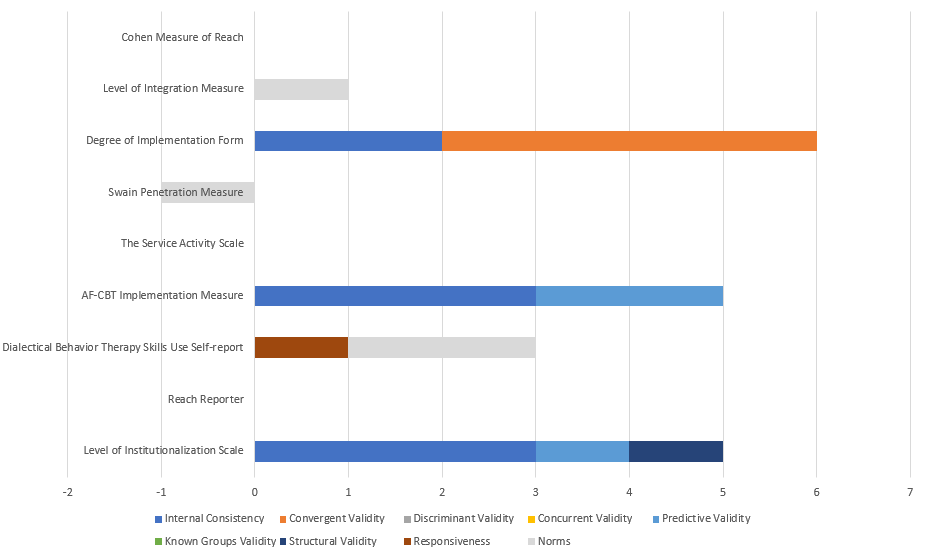Penetration is defined as the integration of a practice within a service setting and its subsystems. (Proctor et. al., 2011)
To see the head-to-head comparisons of the evidence-based assessment rating profiles for the instruments listed below, please click on the image below.
35-item instrument to evaluate the degree to which practitioners reported using various AF-CBT treatment practices in the past six months (items not available).
Tailored tracking sheet to collect REACH data for an “Advancing Care Together” intervention (items not available).
Instrument developed as a specific measure of the degree to which the Transitional Relationship Model is being implemented in practice (items not available).
Dialectical Behavior Therapy Skills Use Self-Report
A self-report item asking about use of DBT skills learned at 2, 7, 11, and 15 weeks following training.
Level of Institutionalization Scale
30-item instrument measuring the level of institutionalization of health promotion programs.
35-item instrument assessing clinic system integration, provider beliefs, commitment to integrated care, clinical practices, interdisciplinary alliances, training and consultation, and leadership.
Instrument including data on the (1) number of target patients seen at the practice during the 3-month period, (2) number of target patients screened for targeted primary care or behavioral healthcare conditions, (3) number of screened patients who screened positive, and (4) number of patients screened positive who were referred for further care.
Self-report tool including items assessing appropriate tools for use by ED and MH staff, policies and protocols guiding each aspect of clinical care, including formal referral and discharge procedures, service capability to deliver CBT, and processes to ensure ongoing staff training.
47-item instrument assessing practice evaluation, penetration,
training, supervision and consultation.
Not Suitable for Rating
Barwick Frequency of CAFAS Rating
The number of times clinicians rated the the Child and Adolescent Functional Assessment Scale (CAFAS) in practice was used as in indicator of
actual change in practice.
Fein Penetration Measure
The rate of adoption of the BHS-ED system into clinical practice.
Fortney Measure of Reach
Reach during the 12-month post-period at each CBOC was defined as the total number of patients referred to the depression care manager divided by the total number of patients with a depression diagnosis who were not already receiving specialty care.
Hagedorn Penetration Measure
The percentage of patients approached that agreed to participate and to
compare basic demographic and diagnostic characteristics of those agreeing and declining participation.
Kaner Penetration Measure
Implementation rate: The number of GPs who screened at least one patient using the programme as a proportion of those GPs who agreed to implement it.
Kilbourne Penetration Measure
Percentage of veterans that the Local Recovery Coordinators successfully contacted among those who were on their lists and still alive and able to be contacted, and the percentage of veterans contacted who re-engaged in VA healthcare services.
Kirchner Penetration Measure
The percentage of patients seen in PC with a PC-MHI encounter.
Pace Proportion/Penetration Measure
Pace 2014
Penetration of behavioral health services into primary care setting.
Reid Measure of Reach
Number of smokers that were identified and documented at admission;
received in-hospital counselling from the nurse counselor; received pharmacotherapy during hospitalization; received additional support from UOHI post-hospitalization; were contacted by the IVR system post-hospitalization; were referred to other outpatient resources; and were contacted for outcome assessment.
Uppal Proportion/Penetration Measure
Proportion of clinicians implementing intervention 6-months after training.
Willenbring Penetration Measure
Program leaders were asked to estimate the approximate percentage of unique patients who received specific treatment services.
Wiltsey-Stirman Penetration Measure
Number/proportion of PTSD cases who received CPT since
the last assessment & number of CPT sessions delivered.
Woltmann Penetration Measure
Penetration rate was defined as the number of clients served in the specific evidence-based practice divided by either the number of eligible clients at the agency (if systematically tracked) or the estimated number of eligible clients derived by multiplying the total target population by the corresponding estimated percentage of eligible clients on the basis of the literature.

